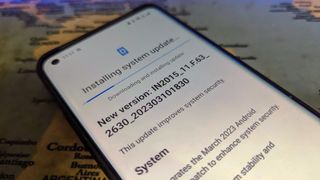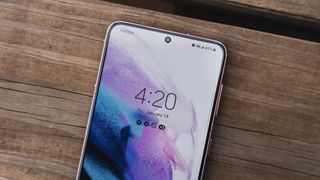I spent hours updating my old phone only to make it worse
It doesn't have to be like this.

I had to switch to an old phone while I try to fix a screen flickering issue with my Pixel 6 Pro. I dug in the pile to find one that could be updated to Android 13 and ended up with the OnePlus 8. The gorgeous Interstellar Glow model still has the volume switch like a proper OnePlus phone should.
A day and about 16GB of downloading later, I realized why a lot of people never bother to update their older phones — because the process sucks.
In the beginning, all Android phones were updated the same way. You were forced to take one update at a time and it took forever and a half for the process to happen once you downloaded the file.
Google fixed the issues through the years by adding a way to use a second partition to make the updating process faster and introducing delta updates, where you only had to install things that actually changed and could roll multiple small updates into a single file.

I wasn't thinking about this when I charged and turned on my OnePlus 8. Frankly, I was thinking about how I was going to remove the display on my Pixel 6 Pro without breaking it so I could push the damn cable the whole way into the socket. A broken screen means about $200 out of my wallet.
I knew there would be an update or two waiting for me. Still, I ended up sitting through four security patch updates, the Android 12 update, a second Android 12 update, the Android 13 update, and a final security patch update. That's about 16GB of data for anyone keeping track and about three hours of my valuable time.
I was curious so I dug out my Pixel 4 and did the same. I got one update that put me on Android 13 with the February 2023 patch. I wish the battery on the Pixel 4 wasn't total trash so I could use it out of spite.
Be an expert in 5 minutes
Get the latest news from Android Central, your trusted companion in the world of Android
One place where OnePlus gets it right is how it uses a separate update partition so you don't have to sit through a long terrible file flash while looking at a boot screen. That's all the company gets right when it comes to Android updates though.

This matters because it's precisely how Samsung does it. OnePlus may make good phones but hardly anyone is using them, while Samsung is the biggest phone maker in the world. You know someone who uses a Samsung phone and chances are you are using one, too.
A lot of those people don't care about updates, and the painful process is part of the reason why. Nobody likes to reboot their phone and will remember the one time they had to do it eight times in one afternoon as I did. Instead, you ignore it and swipe the notification away.
I want to be fair here so I have to say I have no idea if this is something that OnePlus has sorted out with newer models. Samsung hasn't and if you have a Galaxy S21 you haven't turned on for a few years you'll get to go through the same process I did.
At least the software you get is better, though. All those complaints about the Android 13 Color OS whatever it is on the OnePlus forums are genuine. It's so bad that OnePlus created a tool that allows you to roll back. Of course, I didn't read any of that before I started because I do things without thinking them through.
Anyhoo, I still have a phone running Android 13 if I need to test something while I try to work up the nerve to open my Pixel 6 Pro. It just took too long to get here and it's a terrible experience that has me reconsidering how bad the battery on my Pixel 4 really was.

Jerry is an amateur woodworker and struggling shade tree mechanic. There's nothing he can't take apart, but many things he can't reassemble. You'll find him writing and speaking his loud opinion on Android Central and occasionally on Twitter.
